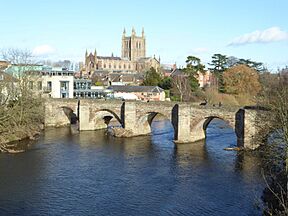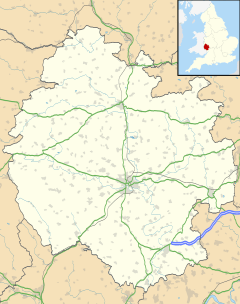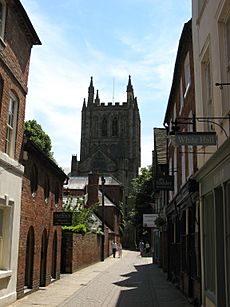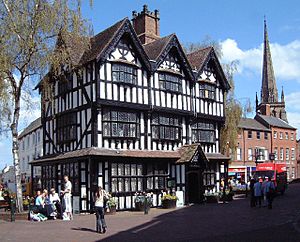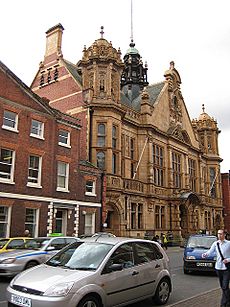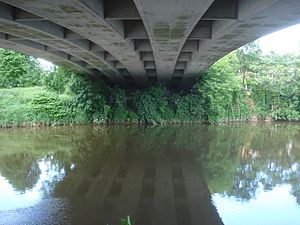Hereford facts for kids
Quick facts for kids Hereford |
|
|---|---|
| City and civil parish | |
|
Clockwise from the top: Hereford City Centre, St Peter's Church, River Wye Bridge & the Cathedral |
|
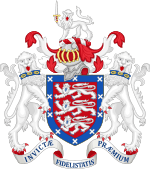 Coat of arms of the City Council |
|
| Population | 53,112 (2021 Census) |
| OS grid reference | SO515405 |
| • London | 135.7 miles (218.4 km) ESE |
| Civil parish |
|
| Unitary authority | |
| Ceremonial county | |
| Region | |
| Country | England |
| Sovereign state | United Kingdom |
| Post town | Hereford |
| Postcode district | HR1, HR2, HR4 |
| Dialling code | 01432 |
| Police | West Mercia |
| Fire | Hereford and Worcester |
| Ambulance | West Midlands |
| EU Parliament | West Midlands |
| UK Parliament |
|
Hereford (![]() i/ˈhɛrɪfərd/ herr-IF-ərd) is a beautiful cathedral city in England. It is the main town of Herefordshire. The city sits on the banks of the River Wye. It is about 16 miles (26 km) east of the border with Wales.
i/ˈhɛrɪfərd/ herr-IF-ərd) is a beautiful cathedral city in England. It is the main town of Herefordshire. The city sits on the banks of the River Wye. It is about 16 miles (26 km) east of the border with Wales.
Hereford has been a city for a very long time. Its city status was officially confirmed again in 2000. In 2021, about 53,112 people lived here. This makes it the biggest town in Herefordshire.
The city is a busy place for farming and trade. Famous products from Hereford include cider (a drink made from apples), beer, leather goods, and even sausage rolls. It is also home to the famous Hereford breed of cattle.
Contents
- What's in a Name?
- A Look Back in Time
- How Hereford is Governed
- Hereford's Location and Weather
- Who Lives in Hereford?
- Getting Around Hereford
- Military Connections
- Hereford's Economy
- City Improvements
- Sports and Fun in Hereford
- Learning in Hereford
- Life and Culture in Hereford
- Sister Cities
- Freedom of the City
- See also
What's in a Name?
The name "Hereford" might come from an old Anglo-Saxon word. "Here" meant an army or group of soldiers. "Ford" was a place to cross a river. So, Hereford might have been a place where soldiers crossed the Wye River.
The Welsh name for Hereford is Henffordd. This means "old road". It probably refers to an old Roman road and settlement nearby. Some old papers even called it "Hereford in Wales".
A Look Back in Time
Hereford became an important religious center around 676 to 688 AD. It grew because it was close to the border between Mercia (an old Anglo-Saxon kingdom) and Wales. By the early 700s, it was the Saxon capital of West Mercia.
There were many fights between the Anglo-Saxons and the Welsh. In 760, the Welsh won a battle here. They became free from English rule. In 1056, the Welsh king, Gruffydd ap Llywelyn, attacked Hereford. He burned the town before going home.
Hereford had the only money-making mint west of the River Severn in the 900s. Important Welsh princes were called to Hereford by King Athelstan.
The Hereford Cathedral we see today was built in the early 1100s. The first bridge over the River Wye was also built around this time.
A small Jewish community lived in Hereford until 1290. That year, King Edward I ordered all Jews to leave England.
Hereford once had a large castle. It was as big as Windsor Castle. This castle helped protect against Welsh attacks. It was also a safe place for English kings. The castle was taken apart in the 1700s. Now, it is a park called Castle Green.
During the Wars of the Roses, a battle happened nearby in 1461. A defeated leader, Owen Tudor, was brought to Hereford. He was executed in High Town. Today, a plaque marks that spot.
The city changed hands many times during the English Civil War. In 1645, a Scottish army of 14,000 soldiers tried to take the city. But the people of Hereford fought back strongly. The Scots left when King Charles I's army came near. The city was finally taken by Parliament's forces in December 1645.
King Charles I was very thankful to Hereford. He added special symbols to the city's coat of arms. These included three lions and ten Scottish Saltires. This showed that ten Scottish regiments were defeated.
Nell Gwynne, a famous actress, is believed to have been born in Hereford in 1650. Another famous actor, David Garrick, was also born here.
The Bishop's Palace, next to the cathedral, was built in 1204. It is still used today. Hereford Cathedral School is one of England's oldest schools.
How Hereford is Governed
The main local government for Hereford is Herefordshire Council. Hereford also has its own "City Council". This council has limited powers.
For a long time, Hereford has been the main town of Herefordshire. In 1974, Herefordshire joined with Worcestershire. They became part of a new county called Hereford and Worcester. Hereford became a district within this new county.
In 1998, Hereford and Worcester split up. Herefordshire and Worcestershire became separate counties again. Hereford lost its district status. To keep its old traditions, a new civil parish council was set up in 2000. Hereford is one of only eight civil parishes in England that has city status. The City Council is based at Hereford Town Hall.
Hereford also has a Member of Parliament (MP). The current MP for Hereford and South Herefordshire is Jesse Norman. He is from the Conservative Party.
Hereford's Location and Weather
Local Climate
Like all of the UK, Hereford has a mild maritime climate. This means temperatures do not change much between seasons. Rainfall is usually moderate throughout the year.
The closest weather station is at Credenhill, about 4 miles (6 km) north-west of the city. Since 2001, the highest temperature recorded there was 33.6°C (92.5°F) in July 2006. The lowest was -15.8°C (3.6°F) in December 2010.
In February 2020, many homes in Hereford had to be emptied because of floods.
| Climate data for Hereford, elevation: 75 m (246 ft), 1981–2010 normals | |||||||||||||
|---|---|---|---|---|---|---|---|---|---|---|---|---|---|
| Month | Jan | Feb | Mar | Apr | May | Jun | Jul | Aug | Sep | Oct | Nov | Dec | Year |
| Mean daily maximum °C (°F) | 7.5 (45.5) |
7.8 (46.0) |
10.5 (50.9) |
13.1 (55.6) |
16.6 (61.9) |
19.3 (66.7) |
21.6 (70.9) |
21.3 (70.3) |
18.6 (65.5) |
14.3 (57.7) |
10.4 (50.7) |
7.6 (45.7) |
14.1 (57.4) |
| Daily mean °C (°F) | 4.4 (39.9) |
4.3 (39.7) |
6.6 (43.9) |
8.5 (47.3) |
11.7 (53.1) |
14.6 (58.3) |
16.7 (62.1) |
16.4 (61.5) |
14.0 (57.2) |
10.5 (50.9) |
6.9 (44.4) |
4.5 (40.1) |
9.9 (49.8) |
| Mean daily minimum °C (°F) | 1.3 (34.3) |
0.9 (33.6) |
2.8 (37.0) |
4.0 (39.2) |
6.9 (44.4) |
9.9 (49.8) |
11.8 (53.2) |
11.5 (52.7) |
9.4 (48.9) |
6.7 (44.1) |
3.4 (38.1) |
1.3 (34.3) |
5.9 (42.6) |
| Average precipitation mm (inches) | 66.4 (2.61) |
46.8 (1.84) |
50.5 (1.99) |
51.7 (2.04) |
51.1 (2.01) |
45.3 (1.78) |
44.9 (1.77) |
47.9 (1.89) |
50.5 (1.99) |
78.2 (3.08) |
64.1 (2.52) |
67.5 (2.66) |
664.9 (26.18) |
| Average precipitation days (≥ 1.0 mm) | 11.0 | 8.5 | 9.5 | 10.4 | 10.0 | 7.7 | 8.6 | 7.3 | 7.7 | 11.9 | 10.9 | 11.6 | 114.9 |
| Source: Met Office | |||||||||||||
Who Lives in Hereford?
In 2021, the census showed that Hereford had a population of 53,112 people. Most people living in Hereford are White (95%). About 2.2% are Asian or Asian British. Other groups make up smaller parts of the population.
When it comes to religion, 57% of people in Hereford are Christian. About 40.7% said they had no religion. Smaller numbers of people follow other religions like Islam, Hinduism, and Buddhism.
Getting Around Hereford
Roads and Bridges
Hereford has always been important for travel. This is because it has a crossing over the River Wye. Today, major roads like the A49 and A438 serve the city. The closest motorway is the M50.
The A4103 road along the north of the city is called Roman Road. It runs in a straight line, just like old Roman roads. Only one main road, the A49, crosses the River Wye using Greyfriars Bridge.
In 2017, Hereford was called "Britain's second slowest city" for traffic. Cars moved at an average speed of 14.09 mph.
Trains
Hereford railway station is north of the city center. It is a stop on the Welsh Marches line. This line connects places like Cardiff and Swansea to the south. It also goes north to Shrewsbury and Manchester.
Transport for Wales Rail manages the station. They run trains to many destinations. West Midlands Railway and Great Western Railway also operate services from Hereford. You can get to Birmingham or even London Paddington from here.
Cycling Paths
Hereford has many paths for cyclists and walkers. These are looked after by Herefordshire Council and Sustrans.
A path runs along the west side of the city. It goes from Newton Farm to Holmer. The Great Western Way route crosses the River Wye on Hunderton Bridge.
National Cycle Route 46 goes from Hereford south to Swansea. There are also plans to extend Route 46 east to Worcester. National Cycle Route 44 starts in Hereford and goes southeast.
Buses
Many bus routes in Hereford are run by a local company called Yeomans Canyon. Other companies like Stagecoach and Newport Bus also run services. You can take a bus from Hereford to places like Gloucester, Monmouth, and Abergavenny.
Military Connections
Hereford is home to the British Army's Special Air Service (SAS). They moved to a base called RAF Credenhill in 2000. This base is now known as Stirling Lines.
The local St Martin's church has a special area in its graveyard. It is set aside as an SAS memorial. Many SAS soldiers are buried there. There is also a Wall of Remembrance for those who could not be buried. This includes 18 SAS men who died in a helicopter crash in 1982.
In 2017, a new sculpture and window were added to Hereford Cathedral. They honor the Special Air Service Regiment.
Hereford's Economy
Hereford has many important employers. These include:
- Herefordshire Council (the local government)
- NHS Herefordshire (healthcare services)
In 2005, Hereford became a Fairtrade City. This means it supports fair prices for goods from developing countries.
Major companies in the city include:
- Bulmers, which makes Cider and other drinks.
- Special Metals Wiggin Ltd, which makes special metal alloys.
- Cargill Meats Europe, which makes food products.
- Painter Brothers, who make metal towers.
Herefordshire is famous for making cider. This is because there are many apple orchards here. Many breweries and related businesses are in the city. Some are at the Rotherwas Industrial Estate.
City Improvements
Many schools in Hereford have been rebuilt and made better. The Herefordshire and Ludlow College has also been updated. In 2021, a new higher education place called NMITE (New Model Institute for Technology and Engineering) opened. It welcomed its first students.
Hereford's main hospital also got a big upgrade. The new Hereford County Hospital was a huge investment for the area. More improvements were made in 2015.
Future Plans for Hereford
A big project is happening in Hereford city center. It is called the Edgar Street Grid. This project covers a large area north of the old city walls. It includes rebuilding the canal basin. The first part of the project opened in 2014. It has a supermarket, cinema, shops, and restaurants.
There are also plans for a new road around the city. This would help with traffic jams. The Rotherwas Industrial Estate has also been given special status. This is expected to create many new jobs.
People have also talked about a second railway station for Hereford. It would be in Rotherwas. Hereford is also expected to get many new homes built by 2026.
Sports and Fun in Hereford
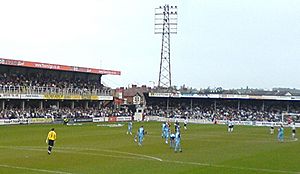
Hereford is home to the football club, Hereford FC. They play at Edgar Street. This club was started after the old team, Hereford United, closed down in 2014. Hereford United was famous for beating Newcastle in an FA Cup match in 1972. Other local football clubs include Westfields and Hereford Pegasus.
Hereford Rugby Club also has plans for a new home. Hereford Stampede is an American football team based at the Rugby club.
Hereford Hockey Club has teams that play in local leagues.
The city also has Hereford Racecourse, where horse races take place. It closed for a while but reopened in 2016. There are golf courses around the city too.
Public Leisure Activities
Hereford's public sports places are run by HALO Leisure. They manage the Hereford Leisure Centre. This center has sports halls, a gym, and squash courts. They also run the Hereford Leisure Pool. It has a swimming pool and a diving pool.
Clubs and Societies
The Hereford Rowing Club uses the River Wye for rowing and other water sports. Hereford has a skittle league, which started in 1902.
There are many other clubs in Hereford. These include the Railway Club, Welsh Club, and the Whitecross Squash & Lawn Tennis Club. Hereford also has music groups, like the Herefordshire Youth Orchestra.
Learning in Hereford
University and Colleges
A new higher education place, NMITE (New Model Institute for Technology and Engineering), started in Hereford in 2021. The goal is for it to become a full University of Hereford in the future.
Hereford has several colleges:
- Hereford College of Arts is an art school. It works with the University of Wales Trinity St Davids.
- Herefordshire and Ludlow College (HLC) offers many courses. It has a university center for the University of Worcester.
- The National School of Blacksmithing is part of HLC. It is the oldest and largest blacksmithing college in the UK.
- Hereford Sixth Form College helps students prepare for university.
- The Royal National College for the Blind is one of the best colleges in Europe for blind students. It hosts major blind sports events.
- Holme Lacy College is an agricultural college. It is also part of HLC.
Schools
Hereford has many secondary schools:
- The Steiner Academy Hereford is the first Rudolf Steiner school in England to become an academy.
- Aylestone Business and Enterprise College is a school for students aged 11 to 16. It specializes in business.
- The Bishop of Hereford's Bluecoat School is a church school for ages 11 to 16. It specializes in technology and languages.
- The Hereford Academy is a high school for ages 11 to 19. It is a Sports College.
- Hereford Cathedral School is an independent school. It is one of the oldest schools in England.
- St Marys RC High School is a Catholic school for ages 11 to 16.
- Whitecross Hereford High School is a specialist Sports College.
Primary schools in the city include Hereford Cathedral Junior School. Other primary schools are Lord Scudamore Academy, St James C of E, St Francis Xavier R.C, and many more.
Life and Culture in Hereford
Farming and Markets
Farming has always been a big part of Herefordshire's history. Hereford City was once the main place for the Cattle Market.
After a disease outbreak in 2001, the market moved. A new Hereford Cattle Market opened in 2011 just outside the city. It has been very successful.
Music Scene
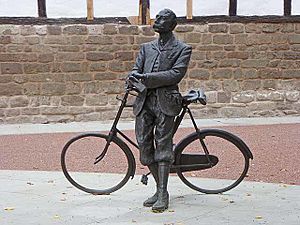
The annual Three Choirs Festival is held in Hereford every three years. It is one of the oldest music festivals in the UK.
The famous composer Sir Edward Elgar lived in Hereford from 1904 to 1911. He wrote some of his best music here. There is a statue of him near the Cathedral Close. One of his famous pieces was inspired by a bulldog falling into the River Wye.
Hereford also has the Hereford Police Male Voice Choir and the Railway Choir. A charity music school is based here too.
Art and Creativity
H.Art, or Herefordshire Art Week, happens every September. It shows off the work of local artists. Many places that are usually closed open their doors during this week.
The sculptor Walenty Pytel has had studios in Hereford since 1963. There is also a bronze statue of a Hereford bull in front of The Old House.
Books and Stories
The fictional commando team Rainbow was based at RAF Hereford in the novel Rainbow Six.
The books Shades of Grey and The Last Dragonslayer by Jasper Fforde are set in Hereford.
Local Media
Local radio stations include Hits Radio Herefordshire & Worcestershire and Sunshine Radio. BBC Hereford and Worcester also broadcasts here. Hereford FC has its own online radio station.
The Hereford Times is the city's weekly local newspaper. Local TV news comes from BBC Midlands Today and ITV News Central.
Fun and Entertainment
The main theatre in the city is the Courtyard Centre for the Arts. It opened in 1998.
There is also an Odeon cinema in the Old Market area. MFA Bowl has a Ten Pin Bowling alley and Mini Golf. Hereford also has a Skatepark on Holmer Road.
Famous People from Hereford
Many interesting people are connected to Hereford:
- Richard Hakluyt (1553–1616) was a writer who helped promote English settlements in North America.
- Nell Gwyn (1650–1687), David Garrick (1717–1779), and Sarah Siddons (1755–1831) were famous actors.
- Major-General Stringer Lawrence (1698–1775) was the first commander of British troops in India.
- The composer Sir Edward Elgar (1857–1934) lived in Hereford for several years.
- Frank Oz (born 1944), the puppeteer for The Muppets and Yoda from Star Wars, was born here.
- The rock bands The Pretenders and Mott the Hoople had members from Hereford.
- Pop singer Ellie Goulding (born 1986) was born in Hereford.
Places to Visit
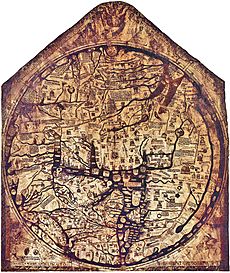
Hereford Cathedral is a must-see. It was built in 1079. Inside, you can find the Hereford Mappa Mundi, a very old map of the world from the 1200s. It also has a special chained library.
The Old House, Hereford is a historic black and white building. It was built in 1621. Today, it is a museum about life in the 1600s.
The Hereford Museum and Art Gallery shows off local art and historical items.
The Museum of Cider teaches you all about how cider is made. It is in an old cider factory. They even have a cider festival in spring and summer.
Holme Lacy House is now a hotel. It was built in the 1500s and has hosted many famous people.
Festivals to Enjoy
Hereford hosts several fun festivals. These include the Beer on the Wye festival and the Hereford Food Festival. The Three Choirs Festival is also a big event.
Sister Cities
Hereford has two sister cities:
- Dillenburg, Germany
- Vierzon, France (since 1994)
Freedom of the City
The "Freedom of the City" is a special honor. Hereford has given it to several people and military groups:
Individuals
- John Masefield: 1930.
- Graham Turner: 2010.
Military Units
- The Herefordshire Light Infantry: 1945.
- RAF Hereford: 1959.
- The King's Shropshire Light Infantry: 1960.
- The Light Infantry: 1971.
- HMS Antelope, RN: 1976.
- The Royal British Legion: 1976.
- The 22nd Special Air Services Regiment: 1981.
- The Burma Star Association: 1982.
- The Rifles: 2008.
See also
 In Spanish: Hereford para niños
In Spanish: Hereford para niños




